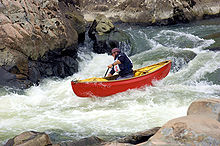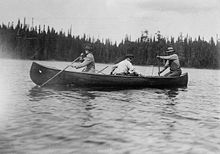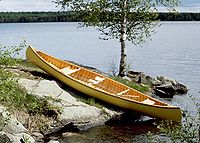


Canadian is the byname used in some countries for the descendants of the birch bark canoe that was used by the indigenous peoples of Northern America as a convenient means of transportation in the densely forested and impassable areas of Northern America.
In the United Kingdom and several other European countries the kayak is considered to be a kind of canoe. (Technically this is understandable, as one can easily see when a whitewater kayak is converted into a decked whitewater canoe just by taking the seat out and paddle it kneeling with a single blade paddle.) To distinguish canoes from kayaks, a touring, whitewater and racing canoe are then often called 'Canadian canoe' or 'Canadian' for short — e.g. Kanadier in German, Kanadensare in Swedish, Canadees in Dutch, et cetera.
History


The use of the byname 'Canadian' is the result of misinterpretations during the development of the sport of canoeing in the 19th century when an open touring canoe was called 'Canadian canoe' from the so called Canadian style canoe from Canada, the then more or less 'approved' open touring canoe by the American Canoe Association (ACA), as opposed to the wood-and-canvas touring canoe from Maine in the United States that was not officially recognized by the ACA until 1934.
For the canoeing clubs and associations of the late 19th century a canoe was a decked, double-ended boat, propelled with a double-blade paddle or sailed. At that time those organizations for large part consisted of somewhat elitist people with the opinion that one should be able to sail well with a touring canoe. Therefore, from the open canoes only the cedar-rib 'Canadian style' canoe was approved by them. The birchbark canoe was considered inferior and its direct descendant the wood-and-canvas canoe "a rag canoe, only suitable for workmen and primitive natives" . The wood-and-canvas canoe was however easier to manufacture and maintain than a cedar-rib canoe and therefore less expensive, which made it much more popular.
In America the canoe lost its qualifying prefix 'Canadian' not long afterwards. In several European countries though, people were not aware of these discrepancies and continued calling all kind of canoes 'Canadians' — even the decked whitewater canoes and, ironically, the wood-and-canvas canoe...
 Birchbark canoe
Birchbark canoe Wood-and-canvas canoe
Wood-and-canvas canoe Cedar-rib canoe
Cedar-rib canoe
See also
Notes
- With the adage "Sail if you can, paddle if you must."
References
- Chisholm, Hugh, ed. (1911). "Canoe" . Encyclopædia Britannica. Vol. 5 (11th ed.). Cambridge University Press. pp. 189–190.
- Swenson, Jeffrey Charles (2007). Canoe Passages: Cross-cultural Conveyance in U.S. and Canadian Literature. University of Iowa.
- MacGregor, Roy (2015-09-08). Canoe Country: The Making of Canada. Random House of Canada. ISBN 978-0-307-36143-1.
General References
Manley, Atwood (1988). Rushton and His Times in American Canoeing. Syracuse University Press. ISBN 0-8156-0141-7.
Moores, Ted; Mohr, Merilyn (2001). Canoecraft, An Illustrated Guide to Fine Woodstrip Construction. Firefly Books Ltd. pp. 8–19. ISBN 0-920656-24-2.
Roberts; Shackleton (1983). The Canoe: A History of the Craft from Panama to the Arctic. Macmillan of Canada. pp. 235–261. ISBN 0-7715-9582-4.
Stelmok, Jerry; Thurlow, Rollin (1987). The Wood and Canvas Canoe. Old Bridge Press. pp. 17–33. ISBN 0-88448-046-1.
External links
- The 'Canadian style' canoe was based on both the dugout and birchbark canoe from the Algonquin and built with a cedar-rib construction, also sometimes dubbed as a "planked dugout"
- The brothers Jacob Henry and William Alfred Payne of Warsaw, Ontario built this dugout canoe circa 1890. Instead of using a cedar-rib construction, they followed the tradition of carving a dugout canoe from a single basswood trunk but adopted the traditional shape of a birchbark canoe. The Algonquin style lines of the craft are related to the area in which the craft was built. The Warsaw, Ontario area is known for its rich canoe racing traditions.